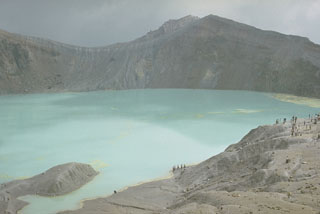Report on Kusatsu-Shiranesan (Japan) — July 1983
Scientific Event Alert Network Bulletin, vol. 8, no. 7 (July 1983)
Managing Editor: Lindsay McClelland.
Kusatsu-Shiranesan (Japan) Small plume emitted; volcanic tremor; A-type events
Please cite this report as:
Global Volcanism Program, 1983. Report on Kusatsu-Shiranesan (Japan) (McClelland, L., ed.). Scientific Event Alert Network Bulletin, 8:7. Smithsonian Institution. https://doi.org/10.5479/si.GVP.SEAN198307-283120
Kusatsu-Shiranesan
Japan
36.618°N, 138.528°E; summit elev. 2165 m
All times are local (unless otherwise noted)
On 26 July a small phreatic explosion occurred at the NW rim of Yugama Crater, at the volcano's summit. JMA personnel observed the eruption, at Pit No. 6, formed during the 26 October phreatic explosion and the site of a similar explosion on 29 December. Volcanic tremor (amplitude 0.2-0.3 µm) started at 1031. About 1110, the dominant frequency of the tremor decreased and white vapor was ejected. Volcanic rumbling intensified at 1140; about 1/3 of the crater lake was covered with ash by 1150. Accompanied by strong rumbling, a dark plume was ejected at [1204]; it had risen above the crater rim by [1212]. Volcanic tremor returned to a higher frequency at 1213, but shifted back to lower frequency about 20 minutes later. Emission of a white vapor plume that rose to about 100 m above the pit was continuous in the afternoon. Volcanic tremor ended at 1720. The plume weakened suddenly at 1730.
Local seismicity had been at a high level since last autumn. Seismographs recorded 209 volcanic earthquakes in June and 227 in July. On 22 July, swarms of A-type earthquakes occurred. After the 26 July eruptive episode, seismicity declined slightly but remained above background level.
Geological Summary. The Kusatsu-Shiranesan complex, located immediately north of Asama volcano, consists of a series of overlapping pyroclastic cones and three crater lakes. The andesitic-to-dacitic volcano was formed in three eruptive stages beginning in the early to mid-Pleistocene. The Pleistocene Oshi pyroclastic flow produced extensive welded tuffs and non-welded pumice that covers much of the E, S, and SW flanks. The latest eruptive stage began about 14,000 years ago. Historical eruptions have consisted of phreatic explosions from the acidic crater lakes or their margins. Fumaroles and hot springs that dot the flanks have strongly acidified many rivers draining from the volcano. The crater was the site of active sulfur mining for many years during the 19th and 20th centuries.
Information Contacts: JMA, Tokyo; T. Tiba, National Science Museum, Tokyo.

